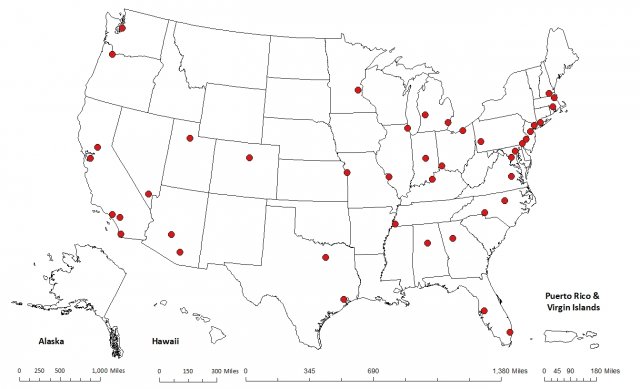Photochemical Assessment Monitoring Stations (PAMS)
Background
The PAMS network is an ozone precursor monitoring network operated by state and local agencies. The PAMS program was originally started in the early 1990s to meet the requirements of Section 182(c)(1) of the Clean Air Act (CAA). Significant revisions to the PAMS requirements (found in 40 CFR part 58, Appendix D) were made as part of the 2015 Ozone National Ambient Air Quality Standard (NAAQS) review. The revised PAMS requirements call for ozone precursor measurements to be made at existing NCore sites (a multi-pollutant monitoring network also required in 40 CFR part 58) in Core Based Statistical Areas (CBSAs) with a population of one million or more . The main objective of the required PAMS sites is to develop a database of ozone precursors and meteorological measurements to support ozone model development and track the trends of important ozone precursor concentrations.
Each required PAMS site is expected to measure:
- Hourly averaged speciated volatile organic compounds (VOCs),
- Three 8-hour averaged carbonyl samples per day on a 1 in 3 day schedule, or hourly averaged formaldehyde,
- Hourly averaged O3,
- Hourly averaged nitrogen oxide (NO), true nitrogen dioxide (NO2), and total reactive nitrogen (NOy),
- Hourly averaged ambient temperature,
- Hourly vector-averaged wind direction,
- Hourly vector-averaged wind speed,
- Hourly average atmospheric pressure,
- Hourly averaged relative humidity,
- Hourly precipitation,
- Hourly averaged mixing-height,
- Hourly averaged solar radiation, and
- Hourly averaged ultraviolet radiation.
Sites and Data
The following links can be used to collect information on the number and locations of PAMS sites and to download monitoring data.

Quality Assurance and Other Guidance Documents
This section contains links to EPA guidance documents intended to assist monitoring agencies as they implement the PAMS requirements.
Model Quality Assurance Project Plan (QAPP)
-
PAMS Model QAPP Revision 1 (May 2023) (pdf)
- If you anticipate editing the model QAPP for your air agency's use, Editable PAMS QAPP Revision 1 (May 2023) (docx) is available.
Technical Assistance Document (TAD)
Target VOCs
- Current VOC Target List (pdf) (4 pp, 479 KB, October 2, 2017)
- Original 54 PAMS Target VOC Compounds Listed in Their Elution Sequence (pdf) (1 pg, 21 KB, June 1995)
Other Documents
- Enhanced Monitoring Plan Guidance (pdf) (6 pp, 147 KB, May 2017)
- PAMS Network and EMP Guidance (pdf) (9 pp, 161 KB, June 2016)
- PAMS Data Validation and Analysis Training Material (pdf) (64 pp, 3 MB, January 2018)
- NATTS/PAMS Carbonyl Flow Check Technical Memo (pdf) (18 pp, 504 KB, August 2024)
Unified Ceilometer Network (UCN)
- Technical Note on Participation in the UCN (pdf)
- Unified Ceilometer Network Quality Assurance Project Plan (pdf)
Model Standard Operation Procedures
This section contains links to guidance on methods used in the PAMS program.
- Model SOP for Markes/Agilent autoGC (docx)
- DRAFT: Model SOP for CAS autoGC (docx)
- DRAFT: Model SOP for PerkinElmer autoGC (docx)
- Model SOP for Carbonyls Collection (docx)
- Model SOP for Carbonyls Analysis (docx)
- Model SOP for Vaisala CL51 Ceilometer (docx)
- DRAFT: Model SOP for True NO2 Measurement (docx)
Enhanced Monitoring Plans
In addition to the required PAMS sites, the PAMS requirements also call for each state with nonattainment areas classified as moderate or above for any ozone NAAQS and states in the Ozone Transport Region to develop and implement an Enhanced Monitoring Plan (EMP). The objective of EMPs is to better understand ozone formation in specific areas through enhanced ozone and ozone precursor monitoring activities.
Presentations and Training
Below are PAMS presentations from the 2016 National Monitoring Conference:
- Overview of New PAMS Requirements (pdf) (8 pp, 901 KB)
- Overview of Chromatographic Applications (pdf) (37 pp, 7 MB)
- Overview of ORD, NO2, NOx and NOy Measurement Research (pdf) (23 pp, 11 MB)
- Upper-Air Meteorological Instruments: Cost, Installation, Maintenance, and Data use Considerations (pdf) (23 pp, 2 MB)
- Enhanced Monitoring Plans - A Maryland Perspective (pdf) (36 pp, 6 MB)
- PAMS Quality Assurance Implementation Plan (pdf) (11 pp, 614 KB)
- Reviewing the Benefits of PAMS Measurements in the South Central US (pdf) (13 pp, 1 MB)
- Monitoring Network Performance for NMHCs Across 35 Monitors in Texas (pdf) (23 pp, 986 KB)
- Assessment of NOy and True NO2 Measurements Denver CO, San Jose CA & RTP NC (pdf) (24 pp, 2 MB)
